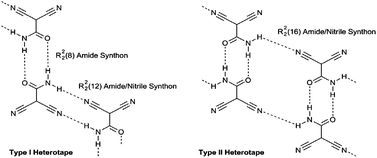A series of five salts of carboamoyldicyanomethanide, C(CN)2(CONH2)−cdm, have been synthesised and structurally characterised using different cations; ammonium (1), methylammonium (2), dimethylammonium (3), trimethylammonium (4) and tetramethylammonium (5). These organic salts vary in the degree of hydrogen-bonding interactions that the cation can partake in with minimal change in the size of the cation. The structure of 1 shows the NH4 cation involved in extensive hydrogen bonding to the cdm anions to form a 3D network with minimal interaction between anions and the disruption of previously observed supramolecular synthons that occur between cdm anions. In contrast to this the structure of 5 contains no hydrogen-bonding between cations and anions and leads to the formation of a corrugated sheet containing only interactions between neighbouring anions. The intermediate cases involving the MeH3N+ (2), Me2H2N+ (3) and Me3HN+ (4) cations, display a 2D hydrogen bonded sheet in the case of 2 and 1D chains in the structures of 3 and 4. The structure of a larger tetraalkylammonium salt, (Et3MeN)cdm (6) contains a similar sheet network to that of the Me4N+ compound with subtle changes due to the increase in size of the counter cation. The role of the steric bulk of the counter-cation has been further investigated by the synthesis of the benzyltrimethylammonium salt of cdm (7) in which the anions form a previously observed 1D chain motif and are well separated due to the bulk of the cation.

You have access to this article
 Please wait while we load your content...
Something went wrong. Try again?
Please wait while we load your content...
Something went wrong. Try again?


 Please wait while we load your content...
Please wait while we load your content...